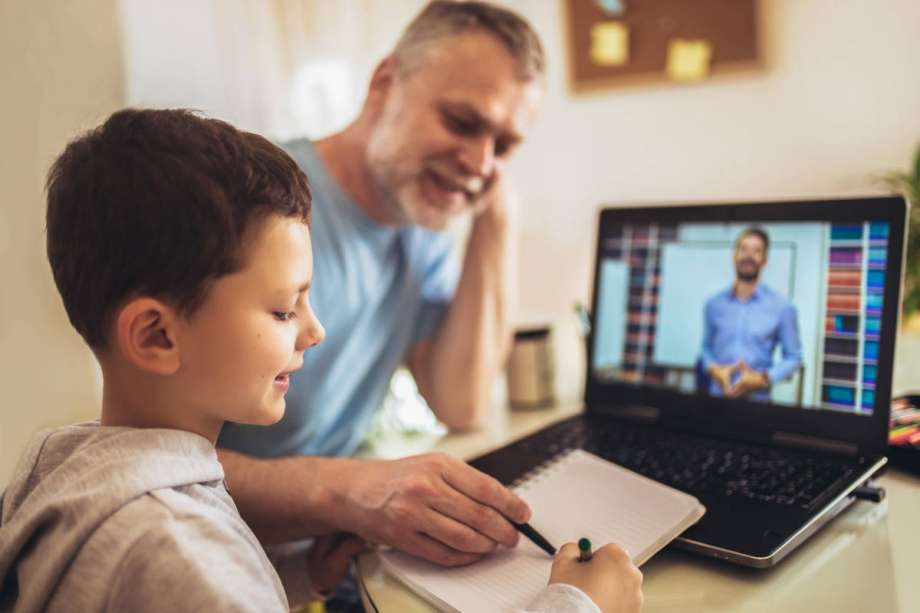How to Help Your Child With Online Learning

Childhood is all about adjustments and transitions. As adults, we know that there will be many times we need to teach children how to adjust their expectations and behavior, or how to be resilient when something changes. But as 90% of children worldwide have been forced into learning from home, helping our children learn to turn to a virtual life full of e-learning was an unforeseen lesson in transition.
More: 8 Reasons Why I Plan to Homeschool Even After the Pandemic
As schools around the country have shuttered and now make plans for how the next school year will look, it’s not unreasonable to think that e-learning will be a large part of our future. As with any challenge, though, there are ways to take advantage of the opportunities presented.
Our kids are no strangers to the computer. Unlike previous generations, they likely know how to use devices better than the grown-ups. That doesn’t mean that they are experts at getting the most out of online learning, though - that’s part of your job as a parent. Here are a few tips to ensure your child is thriving with online learning:
Measure Learning
A recent survey of teachers revealed that 75% are worried that online learning has set their classes back, but luckily most believe they will be able to make up the lost ground. In order to make sure that your child doesn’t fall too far behind, it’s important to maintain certain classroom norms so that they know this is not a vacation. Obligations like assignments, grades, tests, state exams, SATs and ACTs still matter. These aren’t going away just because their medium has changed.
Some ways to encourage this understanding is to continually check in on their learning by working problems together or encouraging them to read their assignments aloud. Simple measurements like self-quizzing or checking problems together can help you stay abreast of their progress. Setting up a reward system for good performance can help them prioritize these measurements, as well.
Avoid Distractions
Most kids have been interacting with devices since the age of two, if not before—but it’s usually been used for fun or as a distraction. Now that the goal has turned to online learning, we have to help them rethink how they use these devices. You can turn off notifications for Apple devices by using “screen time” to limit time on apps, and on Android devices you can turn on “focus mode” to limit access to certain apps during specific times.
Beyond handheld devices, it’s also important to minimize distractions by creating an appropriate space for learning for your child. Whether it be the kitchen table or a designated corner in the living room, try to eliminate as many distractions as possible so that they understand that when they’re in this space, they should focus on their school work.
Encourage Breaks
From instructional blocks to lunch time, schools are built around structure and routine - and a key component of that, regardless of grade, is scheduled breaks. The same should be offered at home, too. Schedule free time, hands-on learning, or walks throughout the day, not to mention lunch and snack breaks, and share when these are going to happen with your child. That way, they can measure their day on a clock, like they would at school.
It’s also important to remember that school is not all about academic learning; a significant portion of what kids learn at school are social skills. While in-person social interactions may be on pause, make sure your child is still maintaining these relationships through video chats with friends. Another idea that can be fun is teaching your child to use email through starting a pen-pal friendship.
Don’t Be Afraid to Get a Tutor
At the end of the day, success in online learning should be achievable - class assignments, quizzes, and tests should largely be doable for you and your student. If you’re finding that your child is repeatedly having trouble, it might be time to reach out to a professional. E-learning relies on the student working largely unobserved - there is no observant teacher that can read his or her body language to know that they might be struggling. Children still need this one-on-one attention, which is why getting a tutor can help.
Tutors are specialists that provide individual attention and can really dig into what works and doesn’t work for your child. They can adjust focus and tactics to make sure that your child doesn’t fall behind. After all, unless you are a teacher, you probably weren’t trained to be an expert in third grade math, or tenth grade biology. Don’t be afraid to call in reinforcements.
For many of us, this is the most uninterrupted time that we’ve gotten to spend with our children and families. Treasure that and take advantage of it - after all there are tutors and teachers that can help your child academically. This isn’t permanent so teach your child what you can and help guide them through this unexpected transition, and most importantly don’t be afraid to ask for help.
Looking for ways to keep the kids busy and learning during the pandemic and summer? Sign up for the Prepared Parent, a daily newsletter filled with everything to help mom and dad in their roles as teacher-parents.
Alexia Mezzini is the co-founder and COO of My Tutor Lab, an education technology company that connects students with verified tutors for one-on-one private sessions. Alexia is a highly sought-after speaker on topics of the supplemental education industry and building upon students’ tremendous knowledge and skills.
Pin these ideas to save them for later: